
A Series by Rachael Roth and Ryan Rosewall
Interviews + Story by Rachael Roth
“The music matters, but a lot comes down to how the girl looks. The girl anchors the stage, sucks in the male gaze, and, depending on who she is, throws her own gaze back out into the audience.” — Kim Gordon, from her memoir, Girl in a Band
The working title of this series was Gaze, as in, the male gaze, which was coined by British film critic Laura Mulvey in her essay “Visual Pleasure and Narrative Cinema” in 1975. But that phrase, used in countless Op-Eds on pseudo-feminist pop culture sites clandestinely backed by corporate behemoths, has been watered down as it appears in our current vernacular. It’s widely accepted as a critique of the way we view women in media, and it’s shaped the way we consume content, yet it’s often disregarded as just another feminist killjoy touchstone.
In the same vein, “crowd pleaser” symbolizes the way an audience interacts with women and nonbinary musicians on and off stage. i.e.:
“That girl is a real crowd pleaser
Small world, all her friends know of me
Young bull livin’ like an old geezer
Quickly release the cash, watch it fall slowly” — Rae Sremmurd
or
“Play a crowd pleaser” — Drunk person at a musical event
In this series, you will hear from women who have had vastly different experiences in their path to musicianship and who hold different ideas of what it means to be a “Girl in a Band,” a “woman in music.” In the photos they are seen in roles created by men, for men, yet with their own styles represented, on their own terms.
“Crowd Pleaser” can frame the way we view women who perform and appear in magazines, or in press photos that try to seduce you as a means to sell records for male executives while the band members themselves only get a fraction of those royalties, which they’ll use for gas fare to the next city on tour, where “fans” will try to finger them onstage, and later tell their girlfriends how the lead singer was good but not fuckable, that they are at best mediocre guitar players or drummers, and will use them as masturbatory fodder while writing their piny, nonconsensual blue-balls-inspired love ballads. Or when female musicians we know and respect who get groped at the bar after the show by their male publicist when they should be reveling in the high of a performance. Or when black female artists are second billing at a music festival while their white male contemporaries are headliners. Or when Yoko Ono, Courtney Love, Jennifer Chiba, and Ariana Grande are held accountable for the actions of their male counterparts in narratives so pervasive that they are still contested decades later. Or when LiveNation continues to promote R. Kelly shows despite allegations of sexual abuse, when Tupac is celebrated in death despite his rape convictions, when sexual misconduct rumors against David Bowie are chalked up to “It was the ‘70s!”, when Leonard Cohen’s and Bob Dylan’s womanizing ways fail to obstruct their fame, success, or reputation.
In this series, I did not want to force the narrative of “victim” on any of these artists. I tried to find women organically, through publicists, by going to shows and working in the music industry, whom I wanted to learn more about. Women who intrigued me had something to say, and navigate the industry and their art in meaningful ways.
And that presented its own set of challenges. We wanted to preserve the artists’ personal images and strengths while conveying a theme rooted in chauvinism. It turns out that can be difficult. It takes the conversation and mind-boggling exploration of your own biases. We wanted these photos to look good; are we just as influenced by the narrow standards of idealized beauty as the rest of society? Can we make a photo pleasing to look at while avoiding sensualism, sexualization, and objectification? Can the artist find power in these historically sexualized environments? Are women on stage or on album covers always “sucking in the male gaze,” or are they sometimes ignored? And what does that say about our ideas of what a woman in music should look like, should be?
I don’t have the answers. But I hope this is the start of a larger conversation about the objectification of female and nonbinary musicians. Or as we like to call them, musicians.
SUPPORT: Please consider donating to womensrefugeecommission.org, Planned Parenthood, and Trans Lifeline.
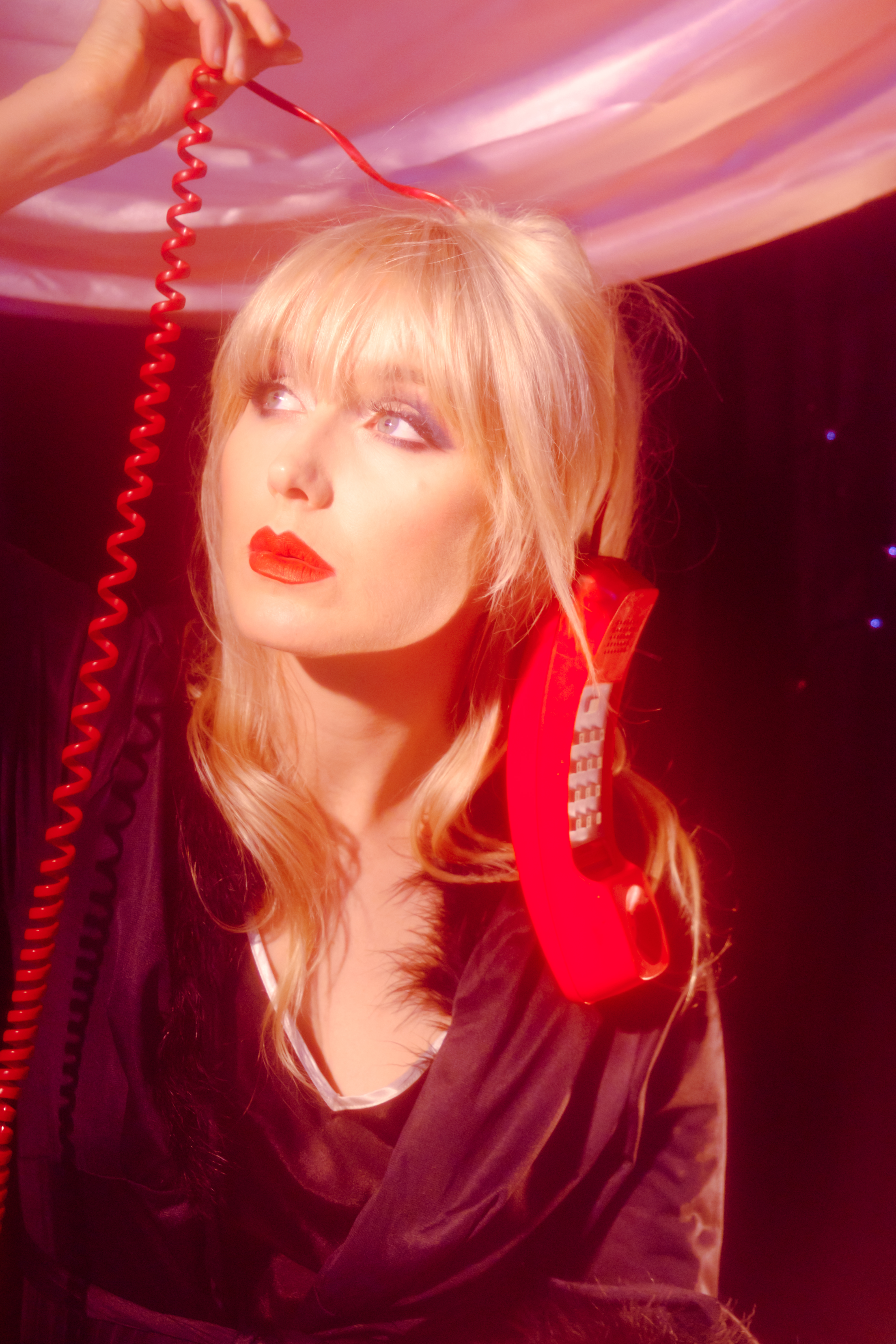

Kate Clover
Bassist, Guitarist, Singer, Songwriter, Music Video Director, Visionary, David Lynch Fan
CROWDPLEASER: When do you feel the most empowered?
KATE CLOVER: On stage, I think it’s just the act of getting up and doing it and not being afraid, and to just accept myself. Do you know what I mean? That’s a very freeing thing. And I think at that point you’ve gone through so many hoops to get up there so it’s like, this is the easy part.
CP: You decided to tour with all women for your last record. What led to that decision?
For about six years or so I was the only girl. And it was something at first that I didn’t really mind, and I’m not anti-male musicians. Sometimes I’ll have a guy guitar player. That’s just natural. I’m not trying to say there are no guys allowed. It was just something where I realized I hadn’t played with any girls the whole time I was playing music. And that just felt so strange. I have tons of girlfriends. So I got a female drummer, and just from there it came together very naturally, and it’s been very different playing with girls. I just feel like I can relax a little bit more. When you’re with a group of your girlfriends, that’s a very different energy than if it’s just you and a group of guys. It’s intimate, you can be a little bit more laid-back. I feel like I have a gang with me.

Photos / Alexa Curran Wardrobe Styling / Ryan Rosewall Hair + makeup / Gladys Diaz Prop Styling + Set Design / Alexa Curran & Ryan Rosewall
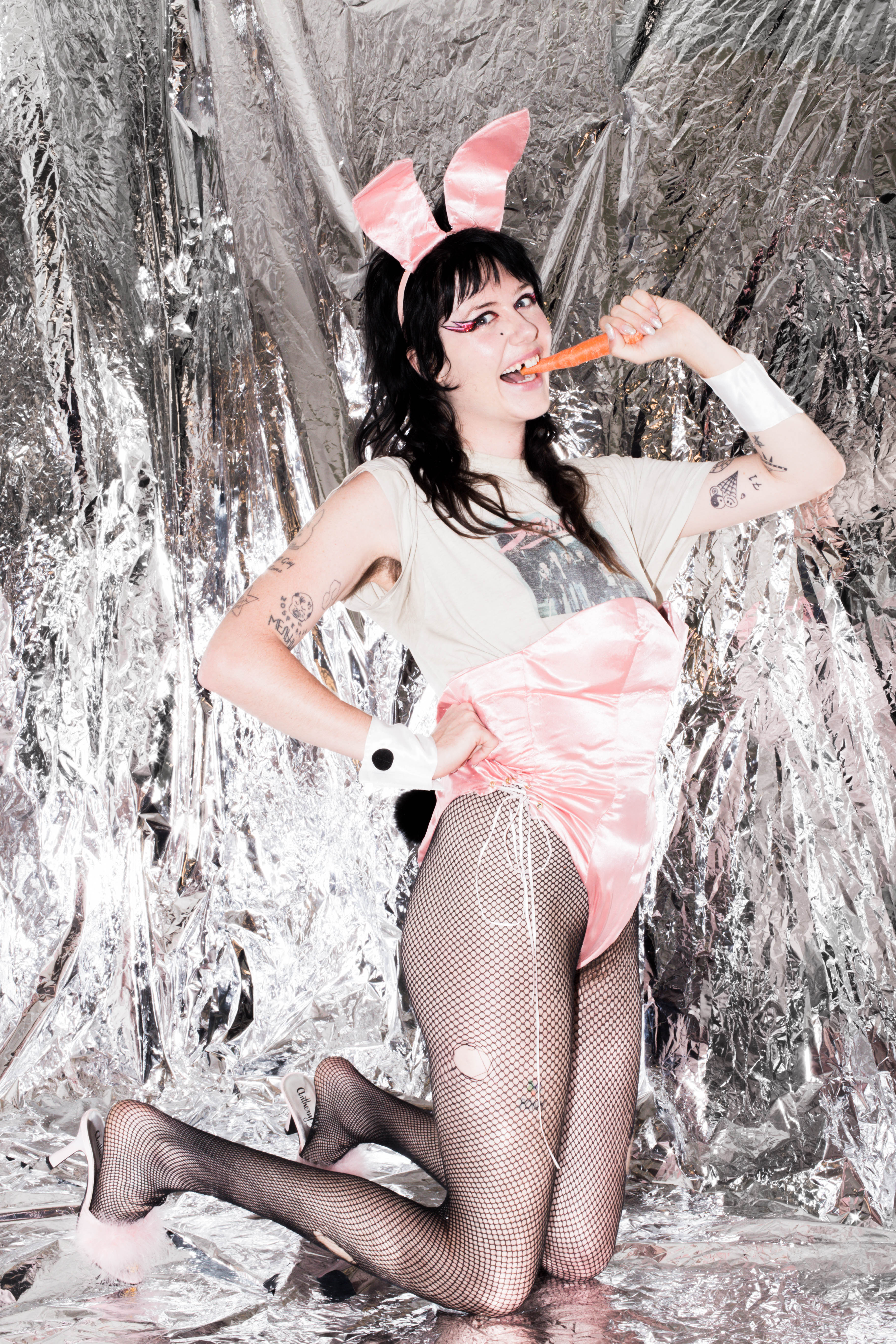

Dani Miller, Alien, Bunny, Musician, Vocalist, Writer, Filmmaker Lead singer of Surfbort
CROWDPLEASER: What makes you feel most powerful aesthetically?
DANI MILLER: I would say I go for the comfy styles and clown styles. I feel like most comfortable when I’m wearing fucked up shit. I feel like myself, like I can do anything, like I’m a little kid. This [ bunny outfit] may look uncomfortable, but I’m really comfortable right now.
My favorite thing is mixing super femme—what you would assume from a traditional feminine woman—and I mix it with [my own style] and non-traditional beauty standards, and mash it up and like, it’s me, what’s up? And let people deal with it. I don’t really get angry with dumb people who treat me differently. I try to educate them and be like, what’s up I’m not gonna be all shiny with big tits ready to fuck. I’m just going to be dancing and screaming in your face.
Do you think movements like #Metoo and recent shifts in the political conversation have changed anything for women making music right now?
People need to be actively, consciously treating other humans, in whatever industry they are in, with dignity and respect. I think the #Metoo was a good perspective-changer for a lot of people though. The most powerful thing we can do in the music scene is to not let abusers who are band members, producers, managers etc. take up space in the community. Don’t support their art, don’t promote their shows. You can’t be an abuser and go about your normal day.

Creator, Producer, Art Director, Interviewer/Writers: Rachael Roth & Ryan Rosewall Photographer: Ryan RosewallSet Design: Ryan RosewallProp Styling: Ryan RosewallHMU: Sydney Costley sydneycostley.comWardrobe Styling: Ryan RosewallBunny Outfit Handmade By: Julia Santilli @dreampersona

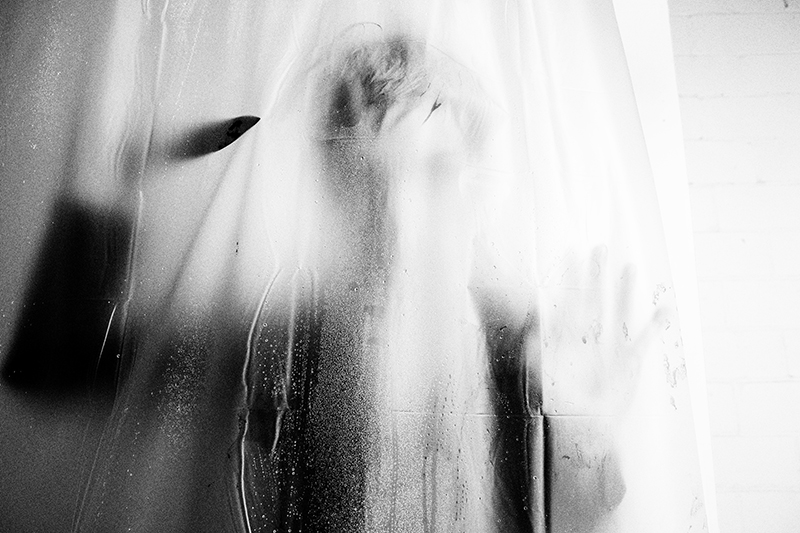
Meredith Graves: Horror Enthusiast, Writer, Musician, Vocalist, Radio Host, Proud Dog Owner
CROWDPLEASER: During our shoot, which is a take on Hitchcock’s ‘Psycho,’ you talked about the limitations placed on female characters in horror movies.
MEREDITH GRAVES: I don’t yet see room for dispassionate or neutral-leaning, awful female villains. And that’s what tells me a lot about how we still perceive who really exists in the role of victim in culture, from the robots of servitude to characters you see women in, even when women were granted access to writers rooms.
I’m not asking for this in any way other than very bluntly stating that this is something I want to be able to play with in terms of fictional narrative in a world that allows for it in ‘Saw’ franchises 1 through 476, we all stopped counting… I just want there to be creativity, and I want there to be room for that, that’s what I’m mad about. We’re just starting to cross into the field of war in terms of actually getting what we need in real life. And it’s a lot more than violence, it’s a lot about money. We need a lot of fucking money, we need a lot of fucking room now. We’re finally starting to talk about not only why we’re not getting the response that we’re not getting, but that we’re also getting sexually assaulted in the creative industry. It’s crazy, but the conversation is just beginning. I’m not saying I know every narrative, I’m not saying I’ve explored even an nth of the genre, at least not to the extent that I want to, but even in the pop realm, I just don’t see there being a lot of room for the truly sociopathic, and I think that that’s a detriment. We need broader diversity than rape revenge in our fiction. Rape revenge is real.
Before the #MeToo movement was referenced as often as it has been in the most recent years, there were allegations against men in the music industry, but I feel like the focus shifted to men in Hollywood. What’s the state of the music industry now in terms of the power imbalance where white men have historically had the upper hand? Are things changing at all?
#MeToo is very important for [the film] industry. [But] there’s actually incredibly important work being done in self-sufficient autonomous groups that are being supported by larger organizations, [for example] for women who are hotel staff in Venezuela. Women are organizing all over the fucking world. #Metoo is one way that actresses are organizing on Twitter. That’s amazing. There are other ways that are other women are organizing. Have we been paying attention to what has been going on with Abolish Ice here in New York city this weekend? Women are organizing marches, women have been organizing sit-ins. Women have been organizing. That’s history. #Metoo is one part of that. It’s a great part of that. Every part is great. Let’s continue organizing. Bash every rapist into paste.
Creator, Producer, Art Director, Interviewer/Writer: Rachael Roth
Photographer: Jen Dessigner www.jendessinger.com
Set Design: Conor Fay conorfay.com
Prop Styling: Ryan Rosewall @rosewvll
HMU: Kristy Strate www.kristymakeup.com
Wardrobe Styling: Ryan Rosewall


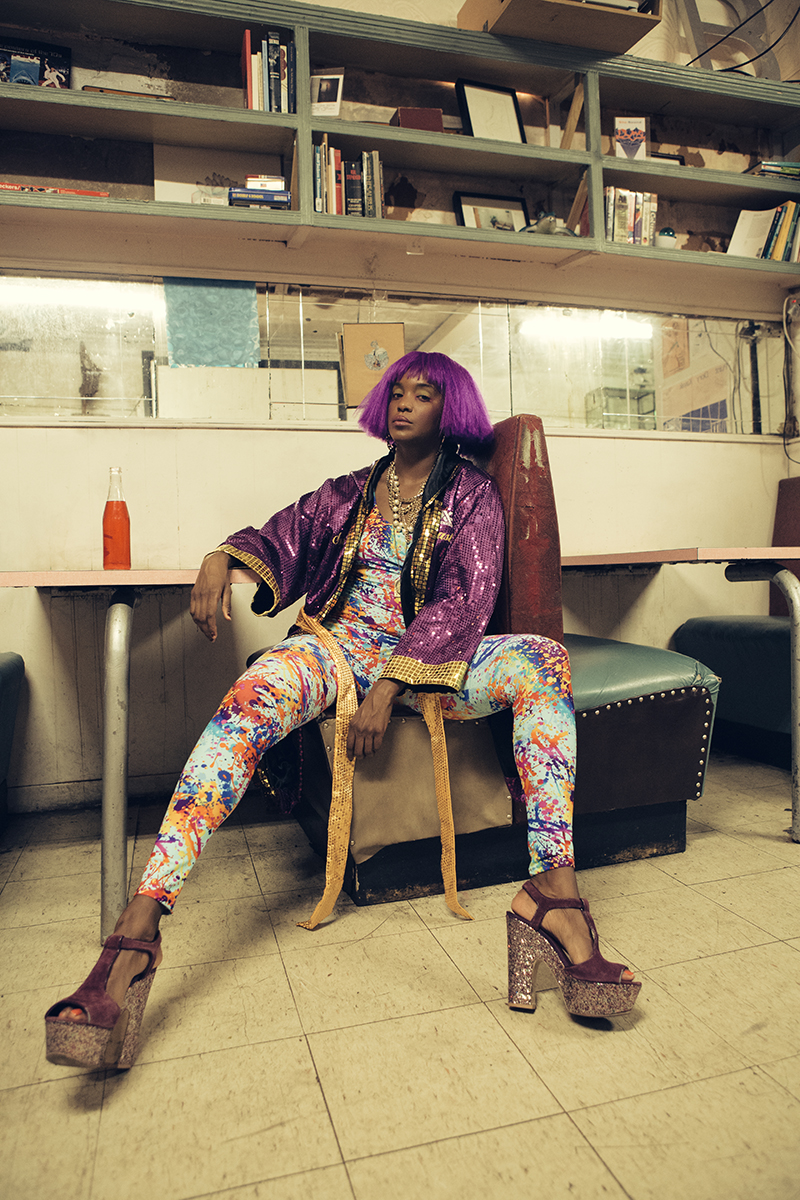
It Hasta Be Shasta Geaux Pop, Ayesha Jordan Performing as: Shasta Geaux Pop
Artist, Performer, Creator, Dancer, Actor, Furniture Maker
CROWDPLEASER: What is the origin of Shasta Geaux Pop?
AYESHA JORDAN: She is from New Iberia Louisiana, and she came about as a reaction to pop culture. It was around the time when Paris Hilton and Nicole Richie kept getting arrested. They were on magazines and TV and I was like ‘wow, you know they’re making a lot of money off this publicity that’s only making them more popular, so if you get drunk and wasted and just do a bunch of dumb shit, you’ll just gain more popularity and get more money.’ There was also this period of time when a bunch of rappers were constantly getting cast in films. And as an artist and actor going in for auditions as often as possible, you realize, I’m not going to get these roles unless I’m already famous. I decided that satire was always a nice way to pull people in, but also address the important subject matter.
Shasta’s songs definitely have a theme of sexual liberation.
I feel like so many people are uncomfortable talking about sex and it can be such an awkward topic depending on who you’re talking to. And I feel like if the conversation was more open and people were more aware of their bodies and what their bodies were capable of, it would change the way we look at it and the conversations around it. When we do [our song] “Kegel to the Beat” [Editor’s note: this is when Shasta instructs audience members to squeeze one another’s shoulders to the beat of a song, mimicking the sensation of kegels], I imagine that once you get past the awkward part of it and you’re laughing but you’re also actually engaging, it becomes an intimate moment that you share with a total stranger. It’s not exactly sexual but you’re activating one of your sexual organs. It creates a space that allows you to open up in a way that maybe you wouldn’t have previously. So hopefully when people leave, if they don’t have that song stuck in their head, they’re going to remember that sensation. They were kegeling with that stranger. Maybe next time they’re in the bedroom or on the toilet or on the train somewhere they’re thinking about this, and it can shift the way they view their sexuality a little bit.
Do you feel like you have full control of your image in the work that you do?
A lot of times people say, well you have to look this part because casting directors don’t have a lot of imagination. And it’s hard for me to buy that. They have imaginations, they just choose not use them. That part of my career I’m still navigating and figuring out. The common problems and issues that tend to come up with making experimental work and making your own work is that you don’t have a lot of money and you have to figure out how to get funded.
Now I have total control of my image. The only time I feel like I don’t have control of my image is if I’m doing someone else’s project where I don’t have a say. I kind of have stopped doing projects like that. It’s tricky for me because I have a way that I want to be able to express myself physically, whether it’s keeping my hair salt and pepper or choosing to not need to have a certain look to get a role. But I think because I don’t play into that sort of game, I just don’t get a lot of those roles [laughs].
Photos / Jen Dessigner Styling / Ayesha Jordan Hair + Makeup / Tyler Fields Shot on Location at Sunview Diner in Brooklyn

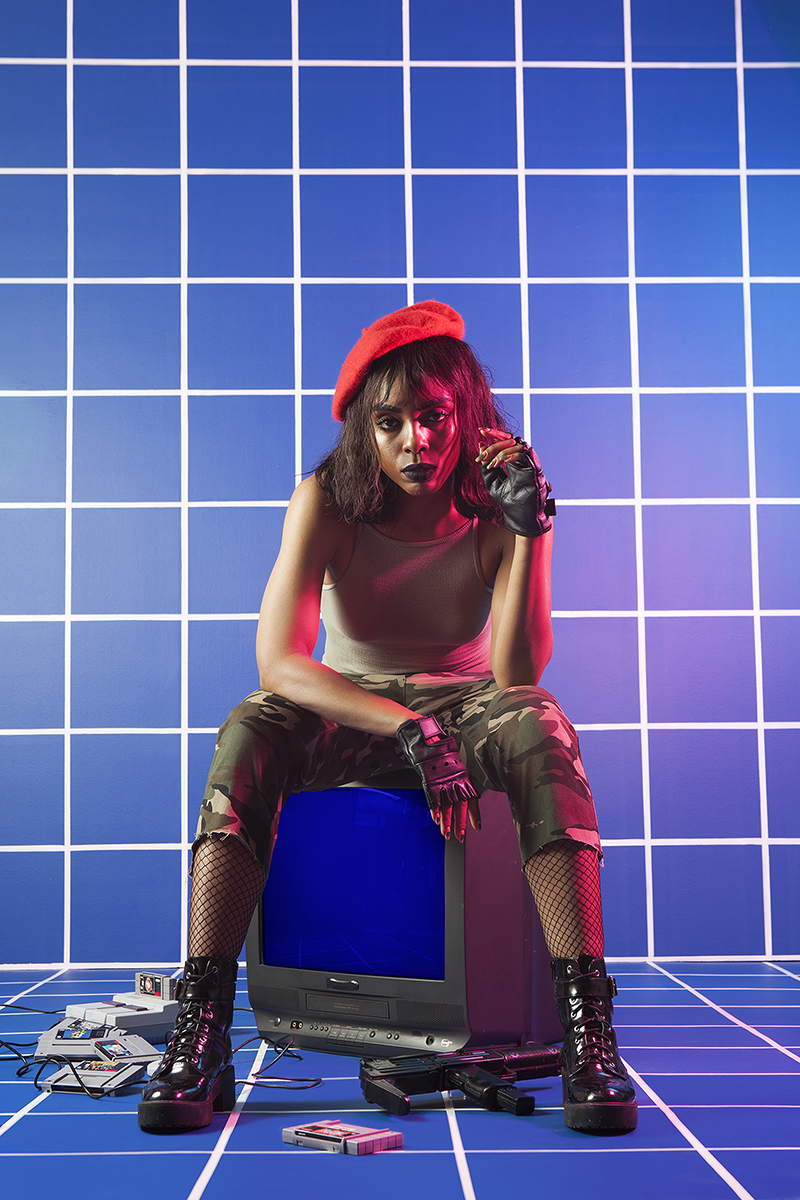
The Irresistible Force of Ehlie Luna
Artist, Performer, Songwriter, Vocalist, Makeup Artist, Director
You said you had to take a break from focusing on your image in order to get people to take your music seriously. What was happening?
I felt like people were confused. I don’t want to become a fashion girl. I love fashion and I think it’s fun, but I feel like I have to lead with my music more. It’s okay maybe later down the line to play with that more. I want people to find me and listen to my music, and maybe if they don’t find you in the right context it’s confusing, which I understand. So I had to chill on that. And if I do it, it has to be that I’m a musician or that I have a project on the way, or doing it around releases. [Image] is something to consider, and it’s the reason that I bought a camera. And I was like, well if I’m going to do images like that, then let it be that I shot them, that I styled it, that I did my makeup. Then it’s my expression, and it’s not simply being a mannequin for other people’s expression.
How important is it to you to collaborate with other women?
It’s hard to choose to pursue a life as an artist, it’s hard in any aspect in the entertainment industry, and I don’t believe we have to make it harder for each other. Why not help each other why not support each other? I’ve been working with women more, even if they’re not in music. How can I support women, how can I make them feel amazing or showcase them? I’ll invite my friends over and I’ll shoot them or do their makeup and then we have this collaboration and it’s so special. I’ve been trying to create that for myself in whatever way I can, and that’s been really fulfilling, too.
Creator, Producer, Art Director, Interviewer/Writer – Rachael Roth rachaelannroth.com Photographers: Carla Liesching www.carlaliesching.com, Widline Cadet www.widlinecadet.com Set Design/Prop Styling: Conor Fay conorfay.com HMU: Ehlie Luna @ehlieluna Styling: Caitlin Dooley www.graceofgrit.com, Rachael Roth
CONNECT WITH CROWDPLEASER
CONNECT WITH DANI MILLER
